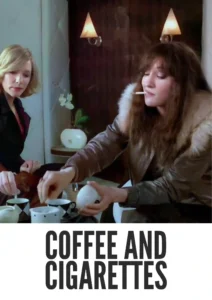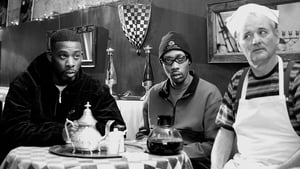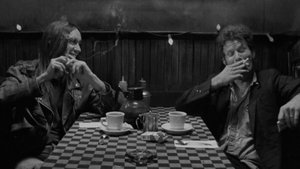Contact: info@alwanfilm.com
Video Sources 0 Views
Synopsis
Coffee and Cigarettes 2004 Colorized Review: A Quirky Anthology of Conversations Over Caffeine and Nicotine

Introduction
Few films capture the essence of life’s simple, fleeting moments quite like Jim Jarmusch’s Coffee and Cigarettes (2004). This black-and-white anthology film is a series of vignettes centered around conversations shared over coffee and cigarettes. These seemingly mundane exchanges offer profound insights into human nature, relationships, and the complexities of modern life. Released in 2004, Coffee and Cigarettes brings together an eclectic mix of characters—some playing exaggerated versions of themselves, others embodying completely fictional personas—resulting in a collection of quirky, humorous, and often profound short stories.
In this review, we will explore the unique structure of Coffee and Cigarettes, delve into its distinctive use of black-and-white cinematography, examine the performances of its diverse cast, and consider its thematic depth. While the film presents itself as a simple series of conversations, there’s much more simmering beneath the surface. Jarmusch’s work is a meditation on the idiosyncrasies of human interaction and the rituals that bind us together.
Check The Full Colorized Movies List
Check Our Colorized Movies Trailer Channel
Understanding Coffee and Cigarettes 2004 Colorized: Director, Cast, and Genre
Director’s Vision
Jim Jarmusch, known for his deadpan humor and minimalist approach to storytelling, conceived Coffee and Cigarettes as a long-term project, spanning 17 years from the first short film in 1986 to its final completion in 2003. The director’s vision was to create a series of interconnected moments that capture the essence of seemingly trivial encounters—small talk, misunderstandings, and the awkwardness that can accompany conversation.
Each vignette in Coffee and Cigarettes focuses on the interplay between characters in a café or diner setting, where coffee and cigarettes become the ritualistic anchors of their interactions. Jarmusch’s minimalist direction, with long takes and deadpan dialogue, allows the film to flow like an observational documentary of life’s quiet moments. The film’s black-and-white cinematography further accentuates the starkness of these encounters, stripping away any distraction and emphasizing the rawness of human interaction.
The Iconic Performance of Actors
One of the most remarkable aspects of Coffee and Cigarettes is its stellar, eclectic cast, composed of actors, musicians, and comedians, many of whom play versions of themselves. The cast is headlined by the likes of Bill Murray, Cate Blanchett, Steve Buscemi, Tom Waits, Iggy Pop, Roberto Benigni, and Jack and Meg White (of The White Stripes).
One of the standout performances comes from Cate Blanchett, who plays dual roles in the vignette titled “Cousins.” In this segment, Blanchett portrays both herself and her fictitious cousin, Shelly. The dual role gives her the chance to display her acting range, as she navigates the subtle tension and awkwardness between the two characters. Her ability to shift seamlessly between the cool, collected movie star and the bitter, envious cousin showcases her incredible talent.
Bill Murray’s vignette, “Delirium,” in which he plays a bizarre version of himself working as a waiter in a diner, sharing a conversation with Wu-Tang Clan members RZA and GZA, is another memorable moment. The juxtaposition of the famed actor with the hip-hop duo creates a surreal but hilarious dynamic. Murray’s self-deprecating humor shines as he plays the role of an unsuspecting caffeine addict caught in an amusingly absurd situation.
Exploring the Genre
Coffee and Cigarettes is an unconventional entry in the comedy-drama genre. It’s not a narrative-driven film with a traditional plot, but rather an anthology of disconnected vignettes that rely on subtle humor and the awkwardness of everyday conversations. Each segment stands on its own while sharing a thematic through-line of coffee and cigarettes as conversational props.
The film can also be categorized as part of the “independent” or “art house” cinema genre due to its minimalist storytelling, avant-garde structure, and unconventional approach to humor. There’s a casual, almost improvisational feel to many of the conversations, which adds to its charm and offbeat appeal.
Exploring the World of Coffee and Cigarettes 2004 Colorized: Plot and Characters
Detailed Synopsis
There isn’t a single plot that drives Coffee and Cigarettes forward; rather, it consists of 11 short vignettes that revolve around characters sitting in diners or cafés, engaging in conversations over coffee and cigarettes. Each vignette is a self-contained narrative, though there are subtle thematic connections between the segments.
Some of the notable vignettes include:
- “Strange to Meet You” (1986): This vignette, one of the first shot by Jarmusch, features Roberto Benigni and Steven Wright. The conversation is delightfully odd, filled with non-sequiturs and awkward pauses, as the two men discuss everything from dental hygiene to their respective nervous tics.
- “Twins” (1989): This vignette stars Joie and Cinqué Lee, siblings who engage in a casual yet awkward conversation with Steve Buscemi, playing a conspiracy theorist waiter. The conversation delves into wild theories about Elvis Presley and his twin brother.
- “Cousins” (2003): Cate Blanchett plays both herself and her fictional cousin Shelly, who is clearly envious of Cate’s success. The passive-aggressive tension between the two is palpable as they try to engage in polite conversation, though Shelly’s resentment bubbles just beneath the surface.
- “Delirium” (2003): This vignette features Bill Murray as a diner waiter who gets into a conversation with RZA and GZA of the Wu-Tang Clan. Murray, who is using coffee to cure a hangover, receives some dubious health advice from the hip-hop duo. The vignette is a surreal, deadpan masterpiece.
- “Somewhere in California” (1993): This vignette stars Iggy Pop and Tom Waits as they meet in a diner, complimenting each other on their respective talents before the conversation veers into absurdity. Their awkward chemistry and strange conversation about quitting smoking (while smoking) is a highlight of the film.
The Complex Protagonist and Memorable Supporting Characters
While there isn’t a single protagonist in Coffee and Cigarettes, the film’s characters each bring their own quirks and complexities to the table. Whether it’s Cate Blanchett’s dual portrayal of herself and her resentful cousin, or the strange yet endearing dynamic between Iggy Pop and Tom Waits, each vignette reveals something about the human condition through the awkwardness, humor, and tension that permeates these short encounters.
What’s particularly fascinating is how Jarmusch allows his actors to play exaggerated or fictional versions of themselves, blurring the line between reality and performance. These characters, though often caricatures, feel relatable in their awkwardness and eccentricities, making the film’s dialogue-driven format deeply engaging.
The Art of Black-and-White Cinematography
Understanding the Visual Choice
One of the most striking aspects of Coffee and Cigarettes is Jarmusch’s decision to shoot the entire film in black and white. This choice enhances the film’s minimalist approach and focuses the audience’s attention on the subtleties of the characters and their conversations. The stark contrast between light and shadow creates a sense of intimacy, drawing viewers into the quiet intensity of each interaction.
The black-and-white palette also heightens the film’s timeless quality, giving the impression that these conversations could happen in any era. It strips away any potential distraction that color might introduce, allowing the audience to focus entirely on the dialogue, body language, and atmosphere. The simplicity of the visual presentation mirrors the simplicity of the film’s premise, creating a cohesive aesthetic.
The Development of Jarmusch’s Style
Jarmusch has long been associated with a minimalist and deadpan style, and Coffee and Cigarettes is no exception. The film’s cinematography aligns with his established visual language, where stillness, long takes, and precise framing are used to emphasize the humor and tension of everyday life. The black-and-white aesthetic complements Jarmusch’s tendency to focus on small, often overlooked moments, making even the most mundane conversations feel profound.
Coffee and Cigarettes 2004 Colorized as a Commentary on Human Interaction
Ritual and Connection
At its core, Coffee and Cigarettes is about the rituals that define human interaction—those small, repetitive actions that provide a framework for social engagement. The ritual of drinking coffee and smoking cigarettes becomes a metaphor for the ways in which people connect, or fail to connect, with one another. These rituals, often mundane and habitual, provide the backdrop for the conversations that unfold, yet they also serve as a unifying force, drawing people together despite their differences.
Whether it’s the awkward politeness between strangers, the tense banter between friends, or the passive-aggressive exchanges between family members, the film captures the complexity of human relationships. Jarmusch highlights the idiosyncrasies of communication, from the pauses and silences to the strange topics of conversation that emerge when people come together over coffee and cigarettes.
The Absurdity of Small Talk
One of the central themes of Coffee and Cigarettes is the absurdity of small talk—the way people fill silence with words that often have little meaning. The characters in the film engage in conversations that range from banal to bizarre, but it’s in these trivial exchanges that deeper truths about human nature are revealed. Jarmusch uses humor and absurdity to highlight the discomfort and awkwardness that can accompany everyday interactions, suggesting that even the most mundane moments are infused with meaning.
The Debate Over Smoking in Film
The Role of Cigarettes in Cinema
One aspect of Coffee and Cigarettes that has sparked debate is its portrayal of smoking. In an era where smoking has become increasingly taboo in films due to health concerns and public opinion, Jarmusch’s film unabashedly embraces cigarettes as a central motif. The characters chain-smoke throughout the film, with cigarettes serving as both a social lubricant and a symbol of rebellion or individuality.
Some critics have raised concerns about the film’s romanticization of smoking, particularly given its potential influence on younger audiences. However, Jarmusch’s use of cigarettes can also be seen as a commentary on addiction, ritual, and the ways in which people use vices to navigate social situations. The cigarettes in the film aren’t just props—they’re integral to the rhythm of the conversations and the dynamics between characters.
The Modern Debate on Smoking in Cinema
In today’s cultural climate, the depiction of smoking in films has become a contentious issue, with many filmmakers opting to exclude or downplay the presence of cigarettes on screen. Jarmusch’s choice to center a film around both coffee and cigarettes can be seen as a nod to an earlier era of cinema, when smoking was commonplace on screen. It also serves as a reflection of the characters’ own contradictions—just as they use cigarettes to fill silences and cope with anxiety, the audience is drawn into the contradictions and complexities of these simple but significant moments.
Influence and Legacy: Coffee and Cigarettes 2004 Colorized in Independent Cinema
The Impact on Anthology Films
Coffee and Cigarettes is often cited as an influential work in the realm of anthology films, a format that Jarmusch has masterfully explored throughout his career. The film’s fragmented structure and focus on dialogue-driven scenes have inspired other independent filmmakers to experiment with similar formats. Its unique blend of humor, introspection, and minimalist aesthetics has made it a cult classic within the indie film scene.
In the years since its release, the film has continued to resonate with audiences who appreciate its offbeat charm and philosophical undertones. Jarmusch’s ability to capture the quiet moments of everyday life with such precision has cemented Coffee and Cigarettes as a landmark in independent cinema.
Conclusion
Coffee and Cigarettes (2004) is more than just a series of conversations over cups of coffee and burning cigarettes—it’s a profound exploration of the rituals, quirks, and absurdities that define human interaction. Jim Jarmusch’s minimalist approach, combined with a stellar cast and the stark beauty of black-and-white cinematography, creates an experience that is as thought-provoking as it is entertaining.
Through its subtle humor and awkward silences, the film captures the essence of what it means to connect with others, even in the most mundane of circumstances. Whether you’re a fan of Jarmusch’s previous work or new to his distinctive style, Coffee and Cigarettes offers a timeless meditation on the complexities of communication and the rituals that bring us together.













